Token Burning: Purpose and Process Explained

Contents
Introduction
Token burning is a common practice in cryptocurrencies. A project deliberately destroys some issued coins to reduce their total supply, according to pre-defined rules or the team’s decision.
At first glance, destroying tokens may seem illogical. But in practice, it’s one way to influence the project’s economy.
Why Tokens Are Burned

Token burning can serve several purposes. It’s important to understand that not all projects achieve meaningful effects through burning—much depends on the context. Here are the main goals for which projects adopt this practice:
-
Reducing total supply. This is the basic objective. The fewer tokens in circulation, the higher the chance that the remaining ones will increase in value if demand rises. But this only works in combination with other factors—burning alone doesn’t create scarcity.
-
Removing unused or “excess” tokens. Sometimes projects issue tokens in reserve for the team, ecosystem, or future features. If some of these tokens become unnecessary, the team may burn them to avoid leaving “dead weight” on the balance sheet.
-
Marketing effect. Token burning is often used as a publicity tool: “Look, we destroyed a million tokens.” This can increase interest in the project, especially if the numbers sound impressive. The effect is short-term but draws attention.
-
Burning is part of the token mechanics. In some projects, burning is integrated into the tokenomics—for example, a certain percentage of every transaction is automatically burned.
-
Indicator of discipline. If a team promises to burn part of its revenue or fees regularly and follows through, it builds trust.
Cryptocurrency projects aim to strengthen their economy and engage token holders through these methods.
Deflationary Effect and Incentive to Ho
Token burning reduces the total supply. If interest in the token remains, its value may rise, just like any scarce resource. This approach is called a deflationary model. It helps prevent devaluation and makes the token more attractive for long-term holding.
Regular token burning signals that the team is focused on long-term development rather than short-term gain. It builds trust in the project and motivates holders to retain their tokens longer. With reduced supply and sustained user interest, the asset gains more stable market dynamics and may appear more attractive to investors.
Token Burning Mechanism

Burn Address and Irreversibility
When a project burns tokens, it sends them to a special address no one can control. This address is called a burn address. It has no private key, meaning no one can access, recover, or spend these tokens.
Technically, the tokens remain on the blockchain but are no longer in circulation. For the system, they are effectively gone, which makes the burning process irreversible.
Such addresses typically have a unique format. For example: 0x000000000000000000000000000000000000dEaD. These addresses are publicly known and used only for burning.
Smart Contract Methods
In many projects, token burning is directly embedded in the code. This is done through functions defined in smart contracts.
Here are two standard methods:
-
Burn function. This deletes tokens directly from a user’s wallet. For instance, when someone voluntarily burns their tokens.
-
Buyback and burn. In this case, the project buys tokens from the market, then sends them to a burn address. This is often automated under preset conditions.
These methods make the process transparent. Anyone can verify that tokens were truly destroyed and didn’t just “disappear.”
Examples from Popular Projects
Token burning is used in many well-known projects. Here are a few examples:
-
Binance Coin (BNB). One of the first primary tokens to implement regular burning. The team destroys a portion of coins each quarter.
-
PancakeSwap. This DeFi project performs weekly burns. Part of the trading and other fees is used to buy and burn CAKE tokens.
-
Shiba Inu. The project actively promotes community-driven burning through campaigns and partnerships. There are even dedicated services that burn tokens manually.
The goal is the same in all cases: reduce the total token supply and maintain interest in the project.
Transparency and Reporting
For the community to trust the process, projects publicly share data on burned tokens. This can include:
-
A dedicated page on the website shows amounts and dates.
-
Posts in blogs or on social media.
-
Links to transactions in blockchain explorers (e.g., BscScan or Etherscan).
For example, Binance publishes a list of all quarterly burns with the exact number of BNB destroyed. This demonstrates that the project is acting transparently and not hiding information from users.
Risks and Criticism

Artificial Price Manipulation
Token burning is a valuable tool. But in some cases, it’s used not for economic impact but for optics. A project may conduct a burn to create an illusion of scarcity without changing market behavior.
Sometimes teams burn a minimal number of tokens but heavily market the event as something significant. This acts as PR: it creates hype, sparks interest, and encourages buying. But the effect fades quickly because there’s no real substance behind it.
If a project constantly emphasizes burning while neglecting product development, that’s a red flag. In such cases, burning may be used simply to hold attention, not to strengthen the economy.
Token Concentration
Another issue arises when burning does not affect the ownership structure. It can increase the influence of large holders.
For example, if an investor held 10% of tokens before the burn and the total supply decreased, their share might grow to 12% or more simply because the total supply is lower. This gives them more voting power and greater market influence.
If a project doesn’t disclose who is burning tokens and in what amount, it can lead to an imbalance. In such cases, burning doesn’t help the community—it worsens inequality.
Conclusion
When done honestly and transparently, token burning can strengthen token economics, attract attention, and incentivize holders.
However, burning should not be viewed as a universal solution. Sometimes it’s just a way to generate hype. That’s why it’s important to evaluate projects critically before investing.
What to Check | What It Indicates |
Is burning done regularly? | It's part of a long-term strategy, not a one-off PR stunt |
Are there clear rules and reporting? | The project is transparent and doesn’t hide data |
Is it clear who controls the tokens before burning? | No hidden increase in large holder influence |
Is there real product development besides burning? | The project creates value beyond burning for appearances |
Does the token have a practical use? | The token serves a function beyond speculation |
If the answers to these questions are clear and transparent, the project truly uses token burning to strengthen its economy, not just for show.